| 1 | Painted bronzeback |
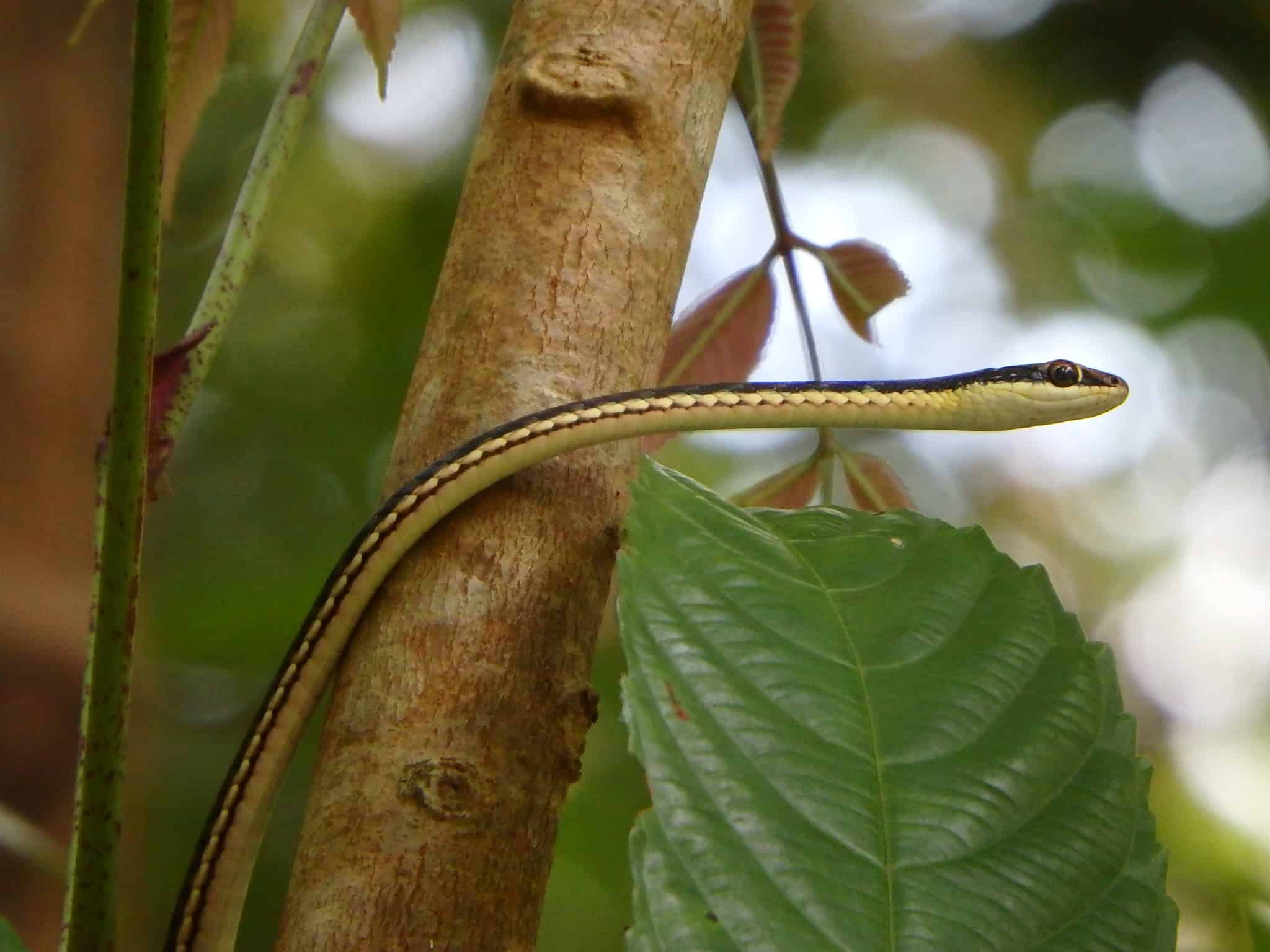
One of Singapore’s most commonly encountered snakes, both in urban areas and rural areas. Painted bronzebacks (Dendrelaphis pictus) are a branch-dwelling species, found mainly on bushes or the lower areas of trees. They’re nervous and fast-moving, and usually skirt away rapidly when humans edge too close. They’re found in 60-70% of Singapore, and appear easily in towns and cities as long as there’s plenty of vegetation. Instead of slashing your way into a forest, you can easily find this snake on the bushes outside a hotel or police station.
Painted bronzebacks average at 60-100cm, with a maximum of 120cm. They’re only slightly venomous, posing no real threat to humans whatsoever. Painted bronzebacks bite humans once in a blue moon, and they don’t really need to, given how fast they can dart away. Painted bronzebacks prey mainly on frogs, with one of their favourites in Singapore being the copper cheeked frog.
Dendrelaphis pictus is often spotted warming itself on large, broad leaves in the early morning sun, or scrambling over rotting logs. One of the best places to find them is the Singapore Botanical Gardens. Painted bronzebacks are recognisable by a brown head and a creamy chin, divided by a black stripe running through their eye. They have one of the redder tongues of any snake, and their pupils are round.
| 2 | Banded flying snake |
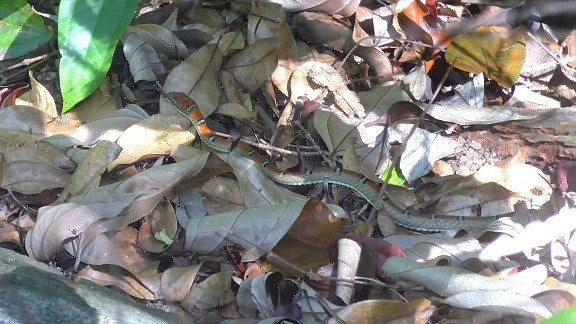
This 60cm species (record 74cm) is found mainly in central Singapore, particularly the ring of untouched nature parks surrounding its forested centre. The banded flying snake (Chrysopelea pelias) is a southerly relative of the golden tree snake, one of Thailand’s most commonly sighted snakes.
This species moves by day, and has only a mild venom. More importantly though, the banded flying snake can fly, and is able to cover 100 metres in horizontal flight distance in a single jump. This is achieved by elongating their vertebrae sideways, creating a reverse U-shaped body, which captures air pockets in the newly formed cavity beneath. These flying skills are mainly used to capture geckos, which they spot on distant branches using their above average eyesight. While this is technically gliding rather than flying, it’s still extremely disturbing to watch if you’re a lifelong ophiophobe.
Banded flying snakes dislike urbanisation, and stay away from Singapore’s bustling cities, with rural gardens being the manmade limit. Top spots include the Bukit Timah Nature Reserve, Windsor and Thomson Nature Parks, and Lower and Upper Peirce Reservoir Parks.
Banded flying snakes are easily recognisable due to the white bands covering their back at regular intervals, and a colourful splashing of red inbetween. Most of their body is grey, interspersed with fine snowy lines bordering some scales. This species coexists with the paradise flying snake in Singapore, but the latter is easy to separate, as it has speckles rather than bands.
| 3 | Western mangrove catsnake |
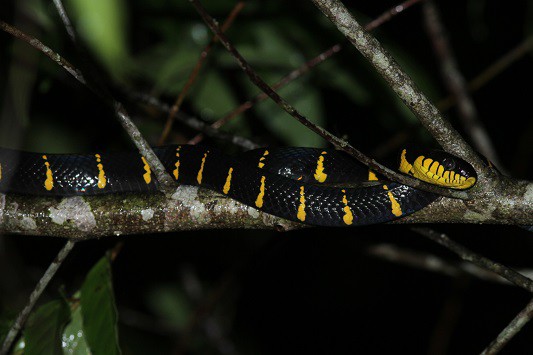
One of Singapore’s largest snakes. Western mangrove catsnakes (Boiga melanota) reach 2.0 metres with ease, with a maximum of 2.5 metres, and have moderately thick bodies. This is one of Singapore’s easiest snakes to recognise, as they have vividly contrasting black-yellow colours, which barely vary. This is also true for their face, with a black cap and a yellow jaw streaked with black lines.
The western mangrove catsnake is a tree-loving snake, which sometimes ventures to the ground, but would rather drape itself over branches for many hours at a time. They’re especially common in the forests of central Singapore, with their main hangouts including Bukit Timah Nature Reserve, Windsor Nature Park, and Lower Peirce Reservoir Park. Mangrove catsnakes are most commonly sighted along lake shores within forests, as they prefer to rest on branches directly over deep water, allowing them to dive rapidly into the depths when escaping.
Mangrove catsnakes have caused no confirmed human deaths, but possess 3 known neurotoxins which make bites risky, including irditoxin, denmotoxin, and boigatoxin-A. This snake was originally a subspecies of the gold-ringed catsnake (Boiga dendrophila), found in eastern Malaysia, but became its own official species in 2020. The two have very similar yellow-black colours, but the Singapore version lacked yellow spots over the dark belly scales, and the yellow stripes never joined together on the spine.
| 4 | Reticulated python |

Being the longest snake in the world, it’s hard to miss the reticulated python wherever they go. This brute is spread across almost all of Singapore, including in urban areas. The reticulated python has taken to using Singapore’s sewer system for transport, slithering around underground tunnels and popping their heads up through storm drains.
In fact, they seem to prefer sewers over the bustling streets above, where they could get run over. In 2021, a Singapore reticulated python poked its head out of a coffee shop toilet, terrifying the owners. Another foolishly climbed 15 feet high and ended up tangled around some festive lights over a street, forcing snake rescuers to step in.
Reticulated pythons are constrictors, with no venom, but are so large (wild record: 6.95 metres) that they’re capable of hunting small humans. One of their countryside hotspots in Singapore is the Sungei Buloh Wetland Reserve, established in 1989. Located in northwest Singapore, this is a place of mangrove forests where binocular-wielding tourists can watch birds from wooden boardwalks.
Reticulated pythons also appear on Singapore’s train tracks and in golf courses. The Windsor and Thomson nature parks are another couple of hotspots, while Boon Lay Place is a residential area where they commonly appear. Being mainly mammal-eaters, reticulated pythons are actually benefitting Singapore overall, by keeping rat populations suppressed.
| 5 | King cobra |
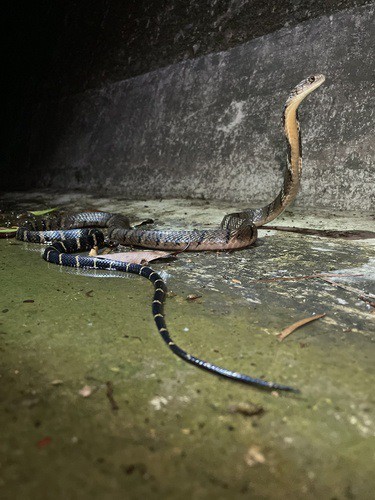
The largest venomous snake found in Singapore (and the world). King cobras are far less common in Singapore than equatorial spitting cobras, and their numbers are falling. They cope decently with agricultural areas, but avoid urbanised streets and sewers.
King cobras reach a record of 5.85 metres, and have a neurotoxic bite which is capable of paralysing, and later killing a human being. 95% of their diet consists of fellow snakes, including venomous species. Fortunately, bites are fairly rare in humans.
One of the king cobra’s hotspots in central Singapore is the 10.3 kilometre MacRitchie Nature Trail. The trail is popular with joggers, and travels through a winding corridor of green foliage, including a 250 metre footbridge with superb views of wildlife. However, one group got a shock in 2021 when a branch started randomly weighing downwards. Closer inspection revealed the presence of a green-tinged king cobra, which could have easily landed on their heads.
In another video, a king cobra was filmed sneaking up on a reticulated python, preparing to inflict a savage bite. But the python fought back, and the two wrestled for 20 minutes before the exhausted cobra finally fled into the bushes. King cobras in Singapore seem to love the taste of reticulated pythons generally – more battles have been spotted at Dairy Farm Nature Park and Sungei Buloh Wetland Reserve. Perhaps this is why the pythons have fled to urban areas such as sewers.
| 6 | Equatorial spitting cobra |
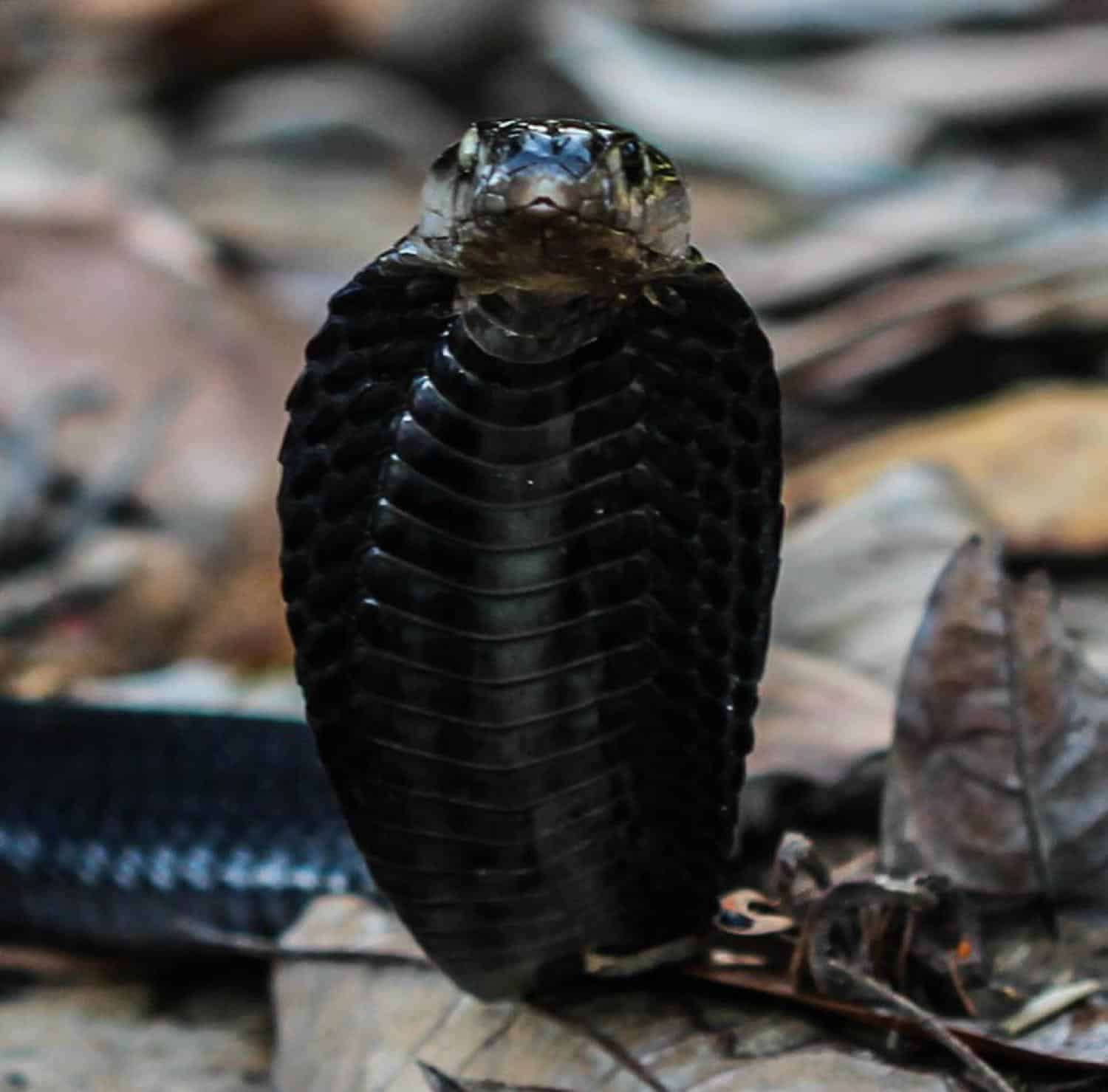
A member of the true cobra genus (Naja), unlike the king cobra, which is the sole member of the offshoot Ophiophagous genus. Equatorial spitting cobras (Naja sumatrana) have a slightly less deadly bite, but can spit venom into your eyes with deadly accuracy.
This species is far shorter than the king cobra, at an average of 90-120cm and a maximum of 150cm. Another difference is that equatorial spitting cobras are far more common in Singapore’s leafy suburbs, even in dense housing estates. Equatorial spitting cobras have even popped up in cemeteries in Choa Chu Kang (northwest Singapore), making the rows of graves even spookier.
Everyone in Singapore has a story to tell about this cobra. In 2023, a king cobra faced off with a gang of otters in an urban park. The otters crawled to the shore as though wanting to adopt the spitting cobra into their gang, but the snake was having none of it. It raised its chest and angled its head forward menacingly, while the otters seemed to realise the danger and started circling the king cobra like a hurricane.
Eventually, they gave up and jumped back into the lake, and the cobra lived up to its side of the bargain by slithering away. Equatorial spitting cobras often invade homes; in 2018, a Singapore maid was forced to whack one to death with a broom handle. Equatorial spitting cobras are usually full black, with a pink tongue, but sometimes have a white stripe on their chest.
| 7 | Brown kukri snake |
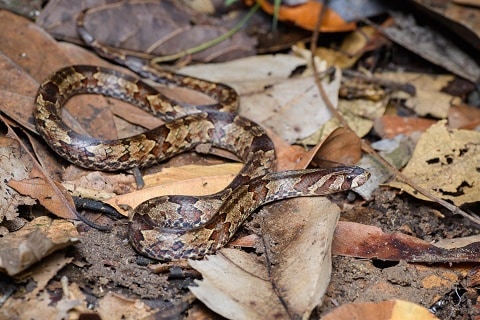
This non-venomous species dwells in Singapore’s leafy forests, well away from the honking cars and pedestrian crossings of housing estates. The brown kukri snake (Oligodon purpurascens) is a shy species which sticks to the ground and often burrows into the soil using its narrow snout. They reach a maximum of 95cm, and when above ground, they tend to hide stealthily below large rocks. Finding this Singapore snake is something of an expedition. You can’t just walk down a footpath; you have to venture into the woods and start upturning every rock and log you find.
Oligodon purpurascens varies in colour, with two common morphs. The first is brown with multiple darker brown bands, each with a near black outline. The second is red with orange bands, and a bright red belly. Despite looking so different, these morphs aren’t a separate subspecies, and they commonly coexist in the woods of Singapore.
Brown kukri snakes cover Singapore, peninsular Malaysia, and just reach extreme southern Thailand. Oligodon purpurascens is recognisable by a dark band that begins at the corner of the mouth, crosses diagonally through the eye, and ends on the forehead.
| 8 | Dwarf reed snake |
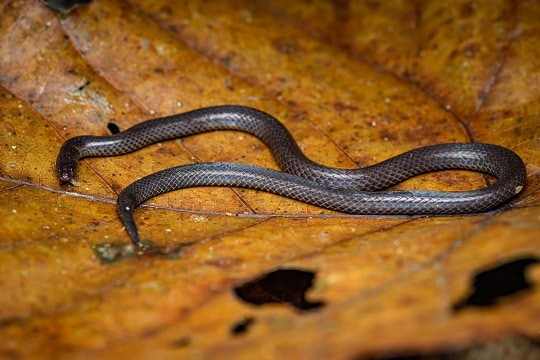
The dwarf reed snake (Pseudorabdion longiceps) is a non-venomous snake which inhabits southern Thailand and peninsular Malaysia, but also has a stronghold in Singapore. This is a very shy species, which spends a large percentage of its life underground, and commonly hides in rotting logs when they do venture to the surface. They measure just 15-20cm, with a maximum of 23cm, and one of their weirdest skills is that they cartwheel to avoid capture.
Though dotted all over Singapore, dwarf reed snakes (Pseudorabdion longiceps) are encountered only rarely. Their main base is probably Bukit Timah nature reserve. This forest sanctuary is located in central Singapore, surrounded by residential areas on all sides, and has so many monkeys (specifically crab-eating Macaques) that visitors are warned not to feed them.
Dwarf reed snakes can often be seen poking their heads out of puddles, with their scales flashing iridescent rainbow colours in response to light. The Singapore Botanical Gardens are another place you might spot them, although they’re so shy that you could equally walk right past. Dwarf reed snakes rarely attempt to bite, and have such tiny mouths that they would probably fail if they did. Their diet includes insect larvae and earthworms.
| 9 | Black-headed collared snakes |
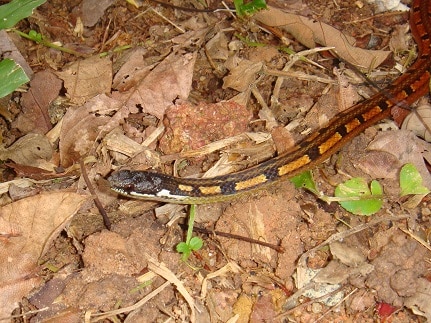
Another staple of Bukit Timah Nature Reserve, which is probably forced to weave in and out of cackling monkeys in order to survive, pretending to ignore them. This is a non-venomous snake, which has no power even to make your fingertip swell up.
Black-headed collared snakes (Sibynophis melanocephalus) are rarely longer than 60cm, and are usually found in freshwater swamps surrounded on all sides by forests. They’re easy to recognise, thanks to a dense black head, and a red upper body which gradually transitions to grey lower down. Its chin and snout are white, which contrasts sharply against their black cap. Sibynophis melanocephalus moves by day, and almost never climbs trees.
Sibynophis melanocephalus constantly ends up as roadkill on Singapore’s forest roads, mainly because of an unfortunate tendency to freeze when confronted by enemies, including the bright oncoming headlights of cars. In forests, this works in their favour, as they have excellent camouflage against a backdrop of fallen twigs and brown leaves (see this pic). Freezing causes their actual enemies to walk right past them, and this might include human explorers searching for them.
Black-collared snakes are also found in peninsular Malaysia, and the southernmost areas of Thailand. Their diet is believed to consist mainly of small lizards like skinks.
| 10 | Mangrove pitviper |
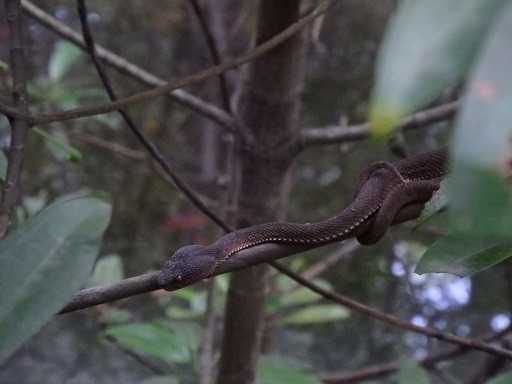
The most common venomous pitviper in Singapore. Mangrove pitvipers (Trimeresurus purpureomaculatus) reside in shallow watery habitats with thick reed clumps sticking up (AKA mangroves), and are rare across most of Singapore. However, they have two strongholds where you can barely move without stepping on one. The first is the protected Sungei Buloh wetland reserve in the northwest, where they live alongside reticulated pythons and scores of migrating birds, often from as far as Siberia. Mangrove pitvipers have a near black colour, and should be visible easily from the wooden boardwalks with binoculars, at least during the day.
The other mangrove pitviper stronghold is the Pasir Ris Park of Singapore’s northeast. This wetland zone is swarming with them, and happens to lie directly adjacent to the notorious Pasir Ris suicide tower, which is officially a bird-watching tower, but now an icon of superstition, said to be haunted.
Stay back if you can, as Mangrove pitvipers have a nasty venom which can cause severe swelling and intense pain almost immediately post bite. There’s no specific antivenom, but luckily, its toxins overlap with the white-lipped pitviper, which does have an antivenom, allowing for cross-neutralisation between the species. Mangrove pitvipers reach an all-time record of 100cm.
